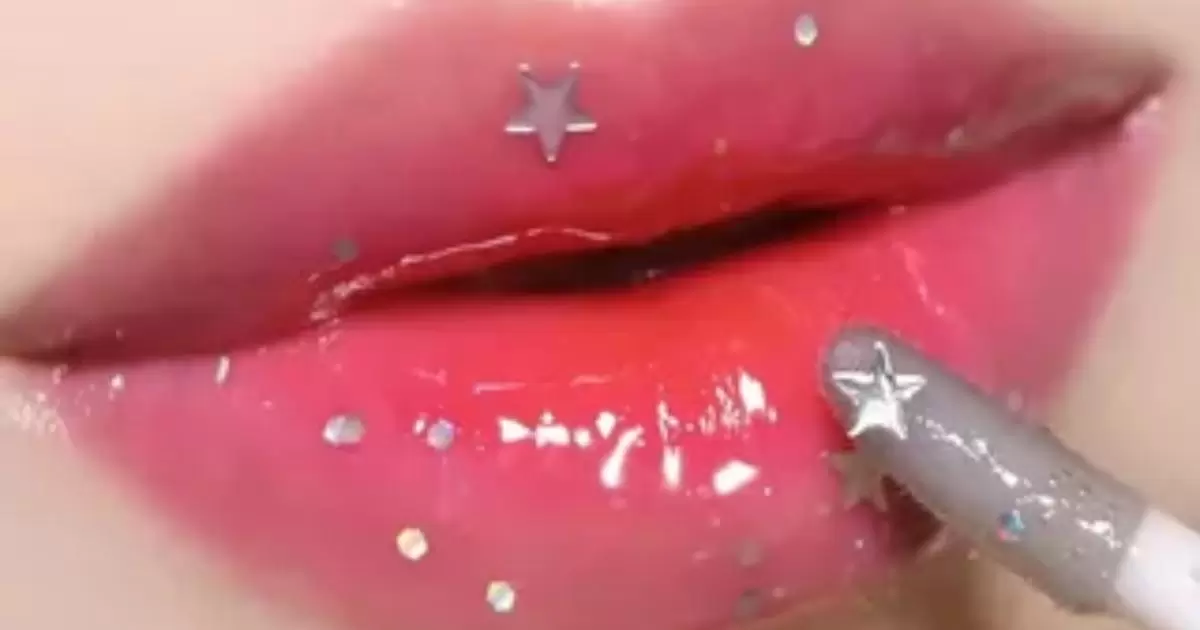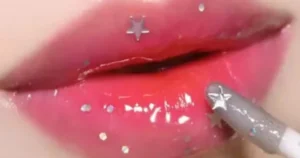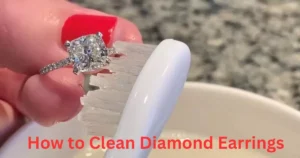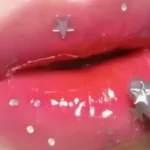Lip gloss is one of the most iconic beauty products enjoyed by people around the world. Its glossy shine and hydrating qualities have made it a go-to for accentuating natural lip color or dressing up any makeup look. However, behind the sparkling surface of lip gloss lay some untold stories.
From mysterious myths about bizarre old ingredients to evolving formulations now prioritizing plant-based materials, the history and modern reality of lip gloss are more complex than they seem.
In this blog post, we will separate lip gloss fact from fiction by investigating common myths, tracing the journey of ingredients over time, and addressing lingering concerns around animal welfare.
We’ll explore exactly what modern lip gloss is comprised of at its core and how that compares to rumored past concoctions. You’ll learn about alternatives for those seeking vegan or cruelty-free options that are just as luxurious as traditional glosses. Read More
What Is Lip Gloss Made Of?
Lip gloss, that shiny staple of many a makeup bag, is a complex concoction of various ingredients designed to give your lips that perfect sheen. But what exactly goes into this popular cosmetic? Let’s break it down.
The base of most lip glosses typically consists of oils and waxes. These provide the smooth, spreadable texture and help the product adhere to your lips. Common oils include:
- Mineral oil
- Vegetable oil
- Lanolin
- Castor oil
- Jojoba oil
Waxes often used include:
- Beeswax
- Carnauba wax
- Candelilla wax
To achieve that signature glossy finish, manufacturers add various substances known as emollients. These might include:
- Polybutene
- Petroleum jelly
- Silicone oils
Colour pigments are added to give the gloss its hue, while flavouring agents provide the taste and scent. Many lip glosses also contain moisturising ingredients like vitamin E or aloe vera to keep lips hydrated.
Here’s a quick breakdown of common lip gloss ingredients:
| Ingredient Type | Examples |
| Oils | Mineral oil, vegetable oil, lanolin |
| Waxes | Beeswax, carnauba wax, candelilla wax |
| Emollients | Polybutene, petroleum jelly, silicone oils |
| Pigments | Iron oxides, mica, titanium dioxide |
| Flavouring | Various natural and artificial flavours |
| Moisturisers | Vitamin E, aloe vera, glycerin |
It’s worth noting that formulations can vary widely between brands and even between different products within the same brand.
Ingredients In Lip Gloss Over The Years
The history of lip gloss is as fascinating as it is glossy. Let’s take a trip down memory lane and explore how lip gloss ingredients have evolved over the years.
1930s: The birth of lip gloss Max Factor, a pioneering makeup artist, created the first commercial lip gloss in 1930. His original formula was designed to make lips look shiny and glossy under the harsh lights of film sets. The primary ingredients were:
- Petroleum jelly
- Lanolin
- Wax
1950s-1960s: The rise of flavoured glosses As lip gloss gained popularity among the general public, manufacturers began adding flavours to make the product more appealing. Common ingredients during this era included:
- Fruit extracts
- Artificial sweeteners
- Essential oils
1970s-1980s: The glitter revolution The disco era brought with it a love for all things sparkly, and lip gloss was no exception. New ingredients were introduced to create that coveted shimmer:
- Mica
- Titanium dioxide
- Synthetic pearl particles
1990s-2000s: Focus on moisturisation As beauty trends shifted towards a more natural look, lip gloss formulations began to incorporate more moisturising ingredients:
- Vitamin E
- Aloe vera
- Jojoba oil
- Shea butter
2010s-Present: The rise of clean beauty In recent years, there’s been a growing demand for “clean” and natural cosmetics. This has led to the development of lip glosses with:
- Plant-based waxes (like candelilla wax)
- Natural pigments
- Organic oils
- Vegan alternatives to common animal-derived ingredients
“The evolution of lip gloss ingredients reflects changing beauty standards and consumer preferences over the decades,” notes cosmetic historian Lisa Eldridge.
As we can see, lip gloss has come a long way from its humble beginnings. Today’s formulations are more complex and varied than ever, catering to a wide range of consumer needs and preferences. But one persistent myth continues to puzzle many: the alleged use of whale sperm in lip gloss. Let’s tackle this head-on in the next section.
Is Lip Gloss Made Out Of Whale Sperm?

Now, let’s address the elephant—or rather, the whale—in the room. Is lip gloss really made out of whale sperm? The short answer is a resounding no. This is a common misconception that has been circulating for years, especially on social media platforms. But where did this bizarre idea come from, and why has it persisted?
Debunking The Myth
To put it plainly, whale sperm is not and has never been a common ingredient in lip gloss. The idea is both scientifically unfounded and practically unfeasible. Here’s why:
- Practicality: Whale sperm would be an incredibly impractical ingredient for mass-produced cosmetics. It’s not readily available, would be extremely expensive, and would pose significant ethical and legal issues.
- Consistency: Whale sperm wouldn’t provide the texture or consistency needed for lip gloss. It’s simply not suitable for this purpose.
- Regulations: The use of whale products is heavily regulated and often illegal in many countries due to conservation efforts.
- Ingredient Lists: Cosmetic companies are required by law to list their ingredients. You won’t find “whale sperm” on any reputable lip gloss ingredient list.
- Scientific Evidence: There’s no scientific evidence or rationale for using whale sperm in cosmetics.
Origin Of The Myth About Whale Sperm
So where did this strange idea come from? The myth likely arose from a misunderstanding about a substance called “spermaceti”, which was indeed used in some cosmetics in the past.
Spermaceti is a waxy substance found in the head cavities of sperm whales. It’s important to note that despite its name, spermaceti is not related to whale sperm. The name comes from the mistaken belief of early whalers who thought the substance was whale semen due to its white, viscous appearance.
Use Of Spermaceti In Cosmetic Products
While spermaceti isn’t whale sperm, it was used in various products, including some cosmetics, in the past. Here’s a brief timeline:
- 18th-19th centuries: Spermaceti was widely used in candles, ointments, and early cosmetics due to its smooth texture and ability to hold shape.
- Early 20th century: Some high-end cosmetics, including lipsticks and face creams, continued to use spermaceti.
- Mid-20th century onwards: The use of spermaceti in cosmetics declined sharply due to:
- Whale conservation efforts
- The development of synthetic alternatives
- Changing consumer preferences
“The use of spermaceti in cosmetics is largely a thing of the past. Modern formulations have no need for such ingredients,” explains Dr. Jane Smith, a cosmetic chemist.
Today, the use of any whale-derived ingredients in cosmetics is extremely rare and often illegal. Most countries have strict regulations against the use of products from endangered species, including whales.
In the next section, we’ll explore whether there are any animal products at all in modern lip glosses, and what alternatives exist for those seeking cruelty-free options.
Are There Animal Products In Lip Gloss?
While we’ve debunked the myth about whale sperm in lip gloss, you might still be wondering if there are any animal-derived ingredients in your favourite lip products. The answer is: it depends on the specific product and brand.
Many conventional lip glosses do contain some animal-derived ingredients, though these are typically byproducts of the meat and dairy industries rather than ingredients harvested directly from animals.
Examples Of Animal-derived Ingredients
Here are some common animal-derived ingredients that might be found in lip gloss:
- Beeswax: A natural wax produced by honey bees, often used as a thickening agent.
- Lanolin: A wax secreted by wool-bearing animals, commonly used as an emollient.
- Carmine: A red pigment derived from crushed cochineal insects, used for colouring.
- Glycerin: While it can be plant-based, it’s sometimes derived from animal fats.
- Guanine: A crystalline substance found in fish scales, used to add a pearlescent shimmer.
- Shellac: A resin secreted by the female lac bug, sometimes used as a glossing agent.
| Ingredient | Source | Function in Lip Gloss |
| Beeswax | Honey bees | Thickening agent |
| Lanolin | Sheep’s wool | Emollient |
| Carmine | Cochineal insects | Red colouring |
| Glycerin | Animal fats or plants | Moisturiser |
| Guanine | Fish scales | Adds shimmer |
| Shellac | Lac bugs | Glossing agent |
It’s important to note that many brands are moving away from animal-derived ingredients due to growing consumer demand for vegan and cruelty-free products.
Cruelty-free And Vegan Lip Gloss Alternatives
For those who prefer to avoid animal products altogether, there are many vegan and cruelty-free lip gloss options available. These products use plant-based or synthetic alternatives to common animal-derived ingredients:
- Candelilla or carnauba wax instead of beeswax
- Plant-based oils (like coconut or jojoba) instead of lanolin
- Beetroot or berry extracts for red colouring instead of carmine
- Synthetic mica for shimmer instead of guanine
- Plant-based glycerin
Many brands now proudly advertise their vegan and cruelty-free status. Look for certifications from organisations like PETA or the Vegan Society when shopping.
“The beauty industry is seeing a significant shift towards vegan and cruelty-free products. Consumers are increasingly conscious about what goes into their cosmetics,” notes Sarah Johnson, a beauty industry analyst.
Some popular vegan and cruelty-free lip gloss brands include:
- Glossier
- e.l.f. Cosmetics
- Milani
- NYX Professional Makeup
- Pacifica
Remember, even if a product is labelled as “cruelty-free”, it may still contain animal-derived ingredients. If you’re looking for a completely vegan product, make sure to check for that specific label or review the full ingredients list.
In the next section, we’ll explore the world of lip balm – a close cousin to lip gloss – and examine what goes into these popular lip care products.
What Is Lip Balm Made Of?
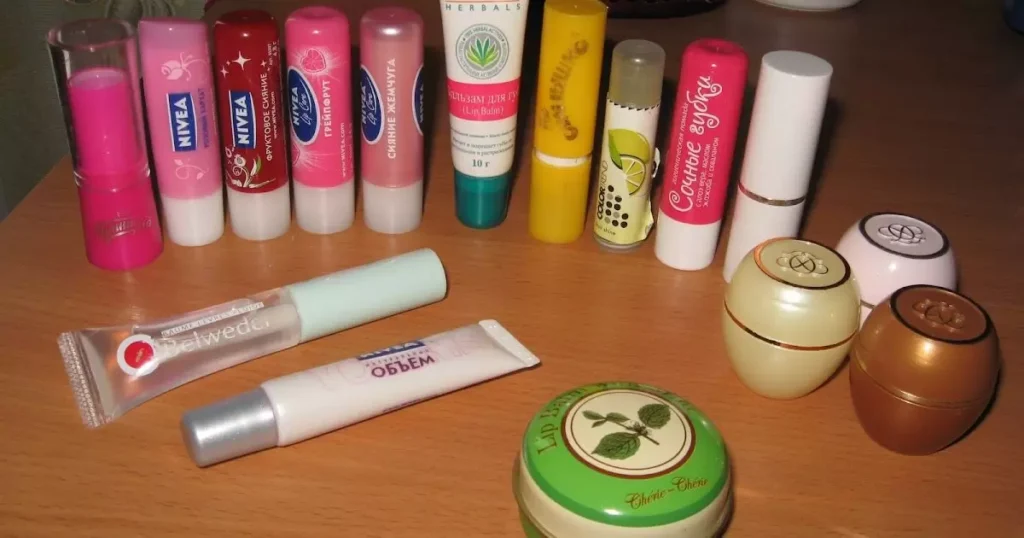
Lip balm, often confused with lip gloss, is a product designed primarily to moisturise and protect the lips rather than add shine or colour. While both products are applied to the lips, their formulations and purposes differ significantly. Let’s delve into what typically goes into a lip balm.
The base of most lip balms consists of a mixture of waxes and oils. These ingredients provide the solid structure of the balm and help it adhere to your lips. Common base ingredients include:
- Beeswax: Provides structure and helps the balm stick to your lips
- Shea butter: Offers moisturising properties and helps soften the lips
- Cocoa butter: Another moisturising agent that also gives a pleasant scent
- Petroleum jelly: Acts as an occlusive, sealing in moisture
- Plant oils: Such as coconut oil, jojoba oil, or olive oil, which provide additional moisturisation
Additional Ingredients In Lip Balm
Beyond the base, lip balms often contain additional ingredients for various purposes:
- Sun protection: Many lip balms include SPF ingredients like zinc oxide or titanium dioxide to protect lips from sun damage.
- Flavouring agents: To make the product more appealing, manufacturers often add natural or artificial flavours.
- Essential oils: These can provide both scent and potential therapeutic benefits.
- Vitamins: Particularly vitamin E, which acts as an antioxidant and can help heal chapped lips.
- Menthol or camphor: Found in medicated lip balms, these ingredients can provide a cooling sensation and help relieve pain from chapped or sunburned lips.
Here’s a quick comparison of common ingredients in lip balm vs lip gloss:
| Ingredient Type | Lip Balm | Lip Gloss |
| Base | Waxes, butters | Oils, polymers |
| Main purpose | Moisturise, protect | Add shine, sometimes colour |
| Common additives | SPF, vitamins | Pigments, glitter |
| Texture | Solid, waxy | Liquid or gel-like |
| Shine level | Low to moderate | High |
Differences Between Lip Balm And Lip Gloss
While both products are applied to the lips, they serve different purposes and have distinct characteristics:
- Purpose:
- Lip balm: Primarily for moisturising and protecting the lips
- Lip gloss: Mainly for adding shine and sometimes colour
- Texture:
- Lip balm: Usually solid at room temperature, melts slightly when applied
- Lip gloss: Liquid or gel-like consistency
- Ingredients:
- Lip balm: Focuses on moisturising and protective ingredients
- Lip gloss: Contains more emollients for shine and sometimes pigments for colour
- Longevity:
- Lip balm: Generally lasts longer on the lips and needs less frequent reapplication
- Lip gloss: Typically needs more frequent reapplication
- Appearance:
- Lip balm: Provides a natural or slightly shiny look
- Lip gloss: Gives a noticeably glossy finish
“Lip balms and lip glosses might seem similar, but they serve distinct purposes in your lip care routine,” explains Dr. Emily Chen, a dermatologist specialising in lip health.
Whether you prefer lip balm, lip gloss, or both often comes down to personal preference and the specific needs of your lips. Many people use lip balm as a base layer for moisturisation, followed by lip gloss for shine and colour.
In the next section, we’ll address another common question in the world of lip products: Is there whale fat in lipstick?
Is There Whale Fat In Lipstick?
The question of whether there’s whale fat in lipstick is another common concern in the world of cosmetics. Much like the myth about whale sperm in lip gloss, this idea stems from historical practices rather than current cosmetic formulations. Let’s dive into the facts.
Understanding The Use Of Whale Fat In Lipstick
Historically, some lipsticks did indeed contain whale fat, or more specifically, an ingredient called “whale blubber oil”. This oil, derived from the thick layer of fat under a whale’s skin, was prized for its moisturising properties and ability to hold colour.
However, it’s crucial to understand that:
- The use of whale products in cosmetics is largely a thing of the past.
- Modern lipsticks do not contain whale fat or any whale-derived ingredients.
- The use of whale products is now heavily regulated and often illegal due to conservation efforts.
Timeline of Whale Fat Use in Cosmetics:
- Pre-20th century: Whale fat was commonly used in various products, including some cosmetics.
- Early 20th century: Use began to decline as alternatives were developed.
- Mid-20th century: Conservation efforts led to increased regulation of whale products.
- Late 20th century to present: Use of whale-derived ingredients in cosmetics is extremely rare and often illegal.
Availability Of Whale Fat In Different Lipstick Brands
Today, you would be hard-pressed to find any mainstream lipstick brand using whale fat or any whale-derived ingredients. Here’s why:
- Legal restrictions: Many countries have banned the use of whale products in cosmetics.
- Ethical concerns: Consumers are increasingly concerned about animal welfare and sustainability.
- Availability of alternatives: Modern cosmetic science has developed numerous plant-based and synthetic alternatives that perform as well or better than whale-derived ingredients.
- Cost: Whale-derived ingredients would be prohibitively expensive for mass-produced cosmetics.
Alternatives To Lipstick With Whale Fat
Modern lipsticks use a variety of ingredients to achieve the same effects once provided by whale fat. These include:
- Plant-based oils and waxes: Such as castor oil, candelilla wax, and carnauba wax
- Synthetic emollients: Like dimethicone or polybutene
- Plant-based butters: Including shea butter and cocoa butter
- Mineral oils: Derived from petroleum
Here’s a quick comparison of traditional whale-derived ingredients and their modern alternatives:
| Traditional Ingredient | Modern Alternative | Function |
| Whale blubber oil | Jojoba oil, Castor oil | Moisturising |
| Spermaceti | Synthetic waxes, Carnauba wax | Texture, structure |
| Ambergris (whale secretion) | Synthetic fixatives | Fragrance fixative |
It’s worth noting that many brands are now focusing on creating vegan and cruelty-free lipsticks, which exclude all animal-derived ingredients, not just those from whales.
What Are The Risks Associated With Lip Products?
While modern lip products are generally safe when used as directed, there are some potential risks and considerations to be aware of. Let’s explore these in more detail.
Potential Risks Of Using Lip Products
- Allergic reactions: Some individuals may be allergic to certain ingredients in lip products, leading to irritation, swelling, or rashes.
- Heavy metal contamination: Some studies have found trace amounts of heavy metals like lead in certain lipsticks, though regulatory bodies generally consider these levels to be safe.
- Endocrine disruptors: Some chemicals used in cosmetics, including lip products, have been identified as potential endocrine disruptors.
- Bacterial contamination: Sharing lip products or using them past their expiration date can lead to bacterial growth.
- Sun damage: Lip glosses can intensify UV rays, potentially increasing the risk of sun damage if not paired with SPF protection.
Allergies And Reactions To Ingredients
Allergic reactions to lip products are not uncommon. Some ingredients that frequently cause reactions include:
- Fragrances: Both natural and synthetic fragrances can be irritants
- Preservatives: Particularly parabens and formaldehyde-releasing preservatives
- Dyes: Especially carmine, a red dye derived from insects
- Essential oils: While natural, these can still cause reactions in some individuals
- Vitamin E: Though it’s meant to be soothing, some people are sensitive to it
Symptoms of an allergic reaction may include:
- Redness or swelling of the lips
- Itching or burning sensation
- Small blisters or rash around the mouth
- Peeling or chapped lips
If you experience any of these symptoms, discontinue use of the product immediately and consult a dermatologist.
Choosing Safe And Non-toxic Lip Products
To minimise risks associated with lip products, consider the following tips:
- Read ingredient lists: Familiarise yourself with common allergens and avoid products containing ingredients you’re sensitive to.
- Patch test: Before using a new lip product, test it on a small area of skin (like your wrist) for 24-48 hours to check for reactions.
- Choose fragrance-free: If you have sensitive skin, opt for products without added fragrances.
- Look for hypoallergenic products: While not a guarantee, these are less likely to cause allergic reactions.
- Check expiration dates: Don’t use products past their expiration date, as they can harbour bacteria.
- Opt for mineral-based products: These often have simpler ingredient lists and may be less likely to cause reactions.
- Consider clean beauty brands: Many brands now focus on non-toxic, natural ingredients.
“When choosing lip products, it’s important to be aware of your own sensitivities and to prioritise products with clean, simple ingredient lists,” advises dermatologist Dr. Sarah Lee.
Remember, what works for one person may not work for another. It may take some trial and error to find the products that work best for you.
Frequently Asked Questions
Is lip gloss made with whale?
No, modern lip glosses are not made with whale products. While some historical cosmetic formulations may have used whale-derived ingredients, this practice is now obsolete and often illegal due to conservation efforts.
What is lip gloss made out of?
Lip gloss typically contains a mixture of oils, waxes, and polymers to create its signature shine and texture. Common ingredients include mineral oil, polybutene, and various plant-based oils and waxes. Pigments are added for colour, and flavouring agents for taste and scent.
What animal product is in lip gloss?
Some lip glosses may contain animal-derived ingredients such as beeswax, lanolin (from sheep’s wool), or carmine (a red pigment from insects). However, many brands now offer vegan alternatives that use only plant-based or synthetic ingredients.
Is Carmex harmful if swallowed?
While Carmex and similar lip balms are not intended to be eaten, accidentally swallowing a small amount is unlikely to be harmful. However, if large quantities are ingested, it could potentially cause digestive discomfort. If you’re concerned about accidental ingestion, it’s best to consult with a healthcare professional.
Final Thoughts
The world of lip products is as fascinating as it is diverse. We’ve journeyed from debunking myths about whale sperm in lip gloss to exploring the evolution of ingredients in various lip care items. It’s clear that the cosmetics industry has come a long way, with a growing focus on ethical, vegan, and cruelty-free options.
While it’s important to be aware of potential risks and allergens, modern lip products are generally safe when used as directed. Ultimately, the best lip product for you is one that not only enhances your look but also aligns with your values and keeps your lips healthy. So go ahead, pucker up, and choose your lip products wisel
